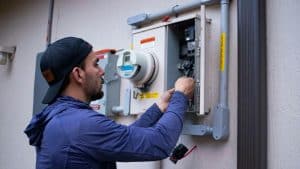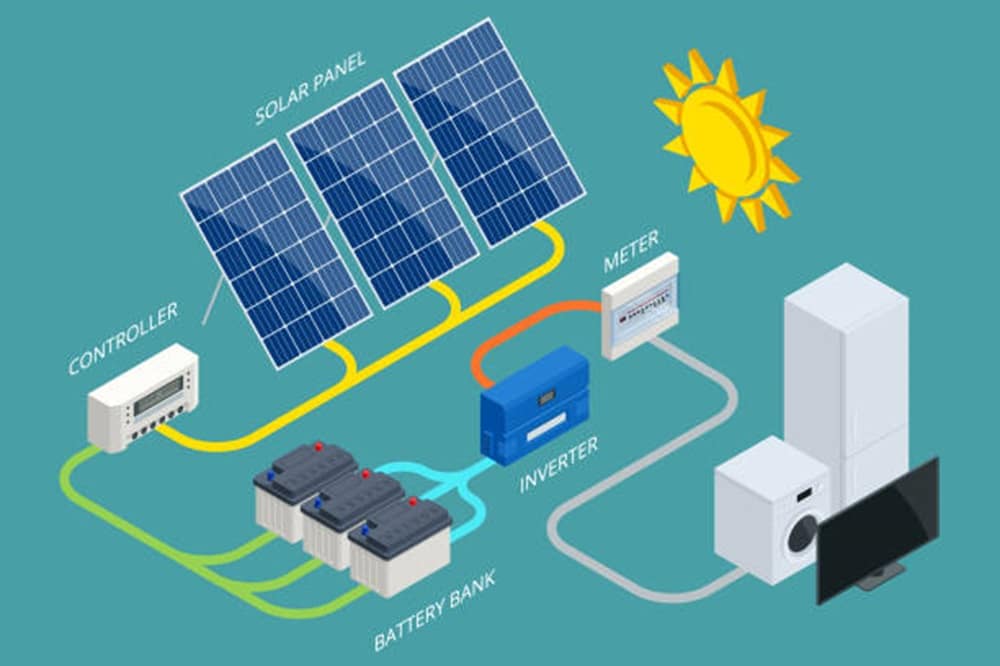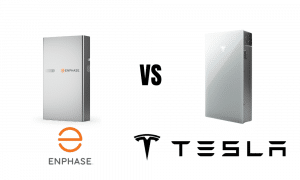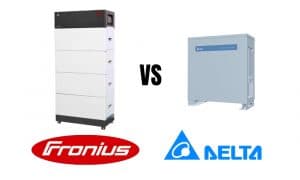In 2024, there are over 250,000 home storage batteries installed in Australia with 57,000 installed in 2023 alone. Most batteries were installed as part of a brand-new solar panel system. However, a significant number of these batteries were added to existing solar systems. This exciting development allows homeowners to unlock the full potential of their solar power, maximising energy independence and reducing electricity bills.
Whether you’re planning a brand new solar installation or looking to add storage to your existing setup, this guide will be your roadmap to a brighter, more sustainable energy future.
How it works
A solar battery captures unused solar power generated during the day, which can be used during the night or on overcast days. Getting a big enough solar battery can make a home less reliant on the grid. Plus, using the stored energy from the battery can be cheaper per kilowatt-hour compared to using from the grid. However, factors, such as the time of the day and the tariffs in the area, must be considered.
A solar battery consists of the following:
- Battery unit: Consider this the heat of the system where the captured energy from the sun is stored. Lithium-ion batteries are the most popular choice because of their high efficiency and long lifespan.
- Inverter: The battery inverter converts the Direct Current (DC) electricity into usable Alternating Current (AC) to power your home. These inverters are in addition to your solar panel inverter. Hybrid solar inverters can handle converting DC electricity directly from the battery.
- Monitoring system: An optional component, a monitoring system allows you to track the system’s performance. You can track the amount of energy your solar panels are generating, how much is being stored in the battery, and how much your home is consuming.
There are two ways to charge a solar battery: AC and DC coupling. AC coupling is a more common method for exiting solar systems. In this charging method, the solar panels generate DC electricity, which is then converted to AC by the solar inverter before being used in the home or fed to the grid. Excess AC power is sent to the battery via the battery inverter for storage. The battery inverter converts the AC power to DC for storage. This is a less efficient method than DC coupling.
DC coupling is usually used for new solar installations. The DC electricity from the solar panels is sent directly to the battery for storage. If needed, the battery supplies DC power to the inverter for conversion to AC and home use. Hybrid solar inverters can channel solar electricity directly to the battery, convert it for the home, or send the excess power to the grid.
Different types of solar batteries

There are four main options to choose from for solar batteries:
- Lead acid: This is one of the most common and oldest battery types. It is also the most affordable but it has a shorter lifespan of five to seven years.
- Lithium-ion: This is the most popular solar battery type in Australia because it’s lightweight and has a long lifespan of up to 15 years. They also require little to no maintenance and are highly efficient.
- Flow: This is a newer type of battery that is made up of liquid electrolytes. It uses two different electrolytes separated by a membrane to store electricity. Flow batteries can last from five to 15 years.
- Sodium and nickel chloride: This is a new technology that uses salt and nickel to generate power. It has a high power density and an average lifespan of 15 years.
The size of solar battery that you need
There are various battery sizes to choose from, which means that you are more likely to find a suitable one for your home. Here are some things to help you:
- Assess your daily energy consumption: Check how much energy your home consumes every day. You can find this information on your electricity bills.
- Inspect your solar panel output: The solar panel output depends on the size of your system and the amount of sunlight your location gets.
- Know battery capacity: This is the amount of energy the battery can store for later use.
- Determine your energy goals: Be clear on what you want to achieve with a solar battery. Do you want to go off-grid completely or do you just want to reduce grid reliance?
- Calculate your energy needs: Know the amount of energy your home uses during the day when your panels are generating solar power. This will give you an idea of the excess energy available to charge your battery system.
- Calculate your night-time usage: Know the amount of energy your home uses at night to show you how much you will need to rely on your battery.
- Consider days of autonomy: This means you need to consider situations like blackouts, storms, etc. The more days of autonomy you need, the bigger the battery you should get.
- Evaluate peak load: Identify the times in which you use the most power, which is also known as the peak load.
- Have room for the future: Consider a battery size that can accommodate any plans, such as building a family, taking in a new member, etc. If you plan to buy an electric vehicle soon, then you should consider that, too.
Battery specifications
Once you have figured out the ones above, it’s time to dive deeper and get into the technicalities—battery specs.
Capacity (kWh)
The battery capacity is measured in kilowatt-hours (kWh), which translates to the amount of energy the battery can store. A 5kWh battery could potentially run a small fridge around 200W for the whole day and a 10kWh battery could power essential appliances in a medium-sized household for several hours during a blackout. If you have a larger home that requires backup power, then a 15kWh battery capacity would work best.
Depth of Discharge (DoD)
DoD is the usable portion of your battery’s total capacity. Battery manufacturers recommend staying within a specific DoD range to optimise battery lifespan. Discharging a battery too deeply too often can degrade its health and shorten its lifespan.
For example, a 19kWh battery with a recommended DoD of 80% provides 8kW of usable energy. You shouldn’t completely drain the battery to preserve its lifespan.
Warranty
A good warranty for your solar battery protects you in case of unforeseen issues. Look for warranties that cover the unit and performance. The length of the warranty is also important—look for coverage ranging from 5 to 10 years.
The best location for your solar battery

The best place for a residential solar battery is the garage. However, it can also be installed indoors and sometimes outdoors but it must comply with the Clean Energy Council’s AS5139:2019. For some who want to install it outside, this will depend on the type of battery that you choose.
The bottom line is, that the place of installation should be cool and dry. If the battery can’t be installed in a garage and must be placed outside, it should be shaded from the harsh sun.
How long does the installation take
Installation of AC-coupled batteries is more straightforward and if there are no issues with the wiring or switchboard, installation could be finished in half a day. For hybrid systems, such as batteries with solar PV or any other components or cables, it may take longer. In this case, it all depends on the size of the team of the solar installer.
How to determine quality solar battery installation
How do you know if the solar battery installation is done right? First, the solar installer should be accredited by Solar Accreditation Australia (SAA) with experience in battery storage systems. This ensures proper system design, component compatibility, and adherence to safety regulations.
Next, the solar installer should create a customised system based on your energy usage, roof space, and desired backup power. Compatibility between new and existing components is important.
The installation should strictly adhere to all relevant electrical safety standards and local building codes. Your solar battery installer should use reputable brands with proven track records for batteries, inverters, and other components.
Your solar installer should also provide you with a transparent cost breakdown, including battery options, installation costs, potential government incentives, and a realistic estimate of return on investment considering energy savings and battery lifespan. Your installer should also be knowledgeable about available federal, state, and local rebates, subsidies, or financing options to help offset upfront costs.
Finally, your solar installer should ensure clear communication and keep you informed throughout the process. They should be able to explain technical details to you in an understandable way and address any questions you may have. Moreover, a good solar installer should provide you with ongoing support following the installation, including guidance on system monitoring and addressing any potential issues.

The paperwork involved

Knowing the kind of paperwork you need in a solar battery installation is important. However, this varies depending on your location and specific system setup.
From your solar installer, you will be given the system design and specifications, which outline the technical details of your planned solar battery system. This also includes the compliance statement that confirms the solar battery installer met all relevant design, installation, and safety standards. Separate warranties will likely be provided for the battery unit, inverter, and the installation.
There is also paperwork involved in permissions and grid connection, such as the network connection agreement, which, in most cases, will be handled by your installer with your electricity distributor. This agreement seeks permission to connect your battery system to the grid and may determine if you can export excess solar energy for a feed-in tariff (FiT). Next are building permits, but these depend on your location and the size of your battery system.
Other documents include manufacturer manuals and government incentives if you’re applying for rebates and subsidies.
With over a quarter-million batteries installed nationwide, and a growing trend of adding them to existing solar panel systems, it’s clear that homeowners are embracing the benefits of solar storage.













































